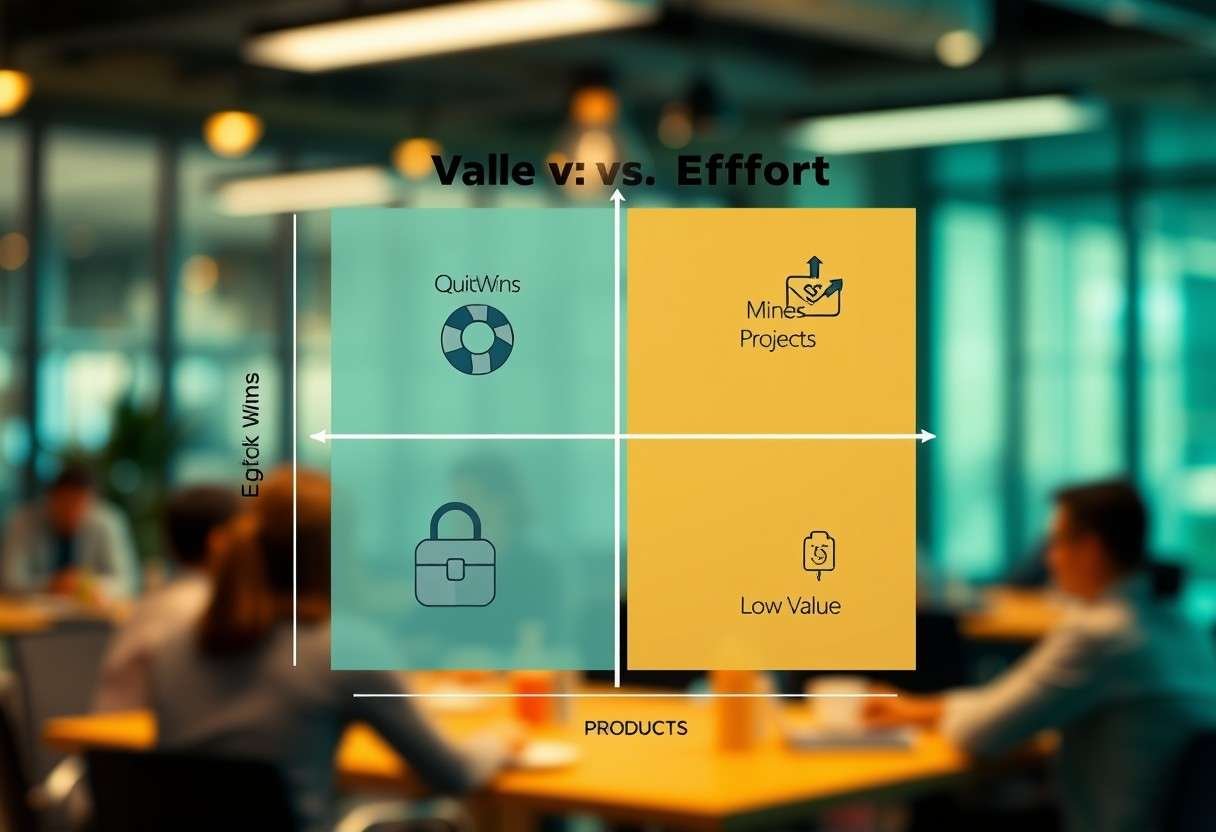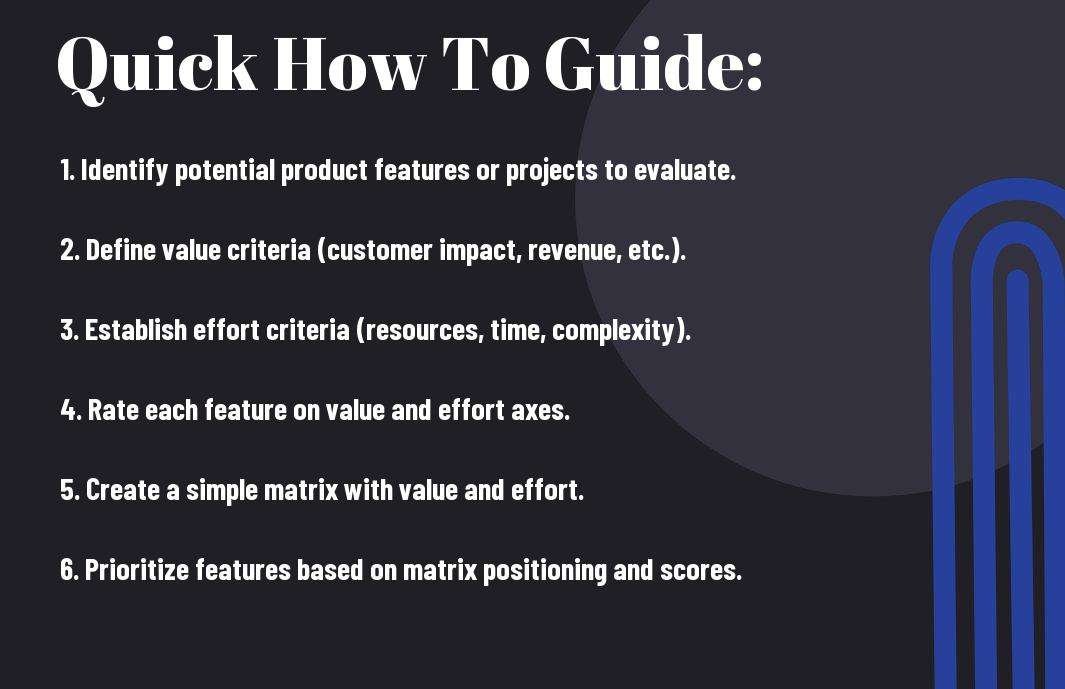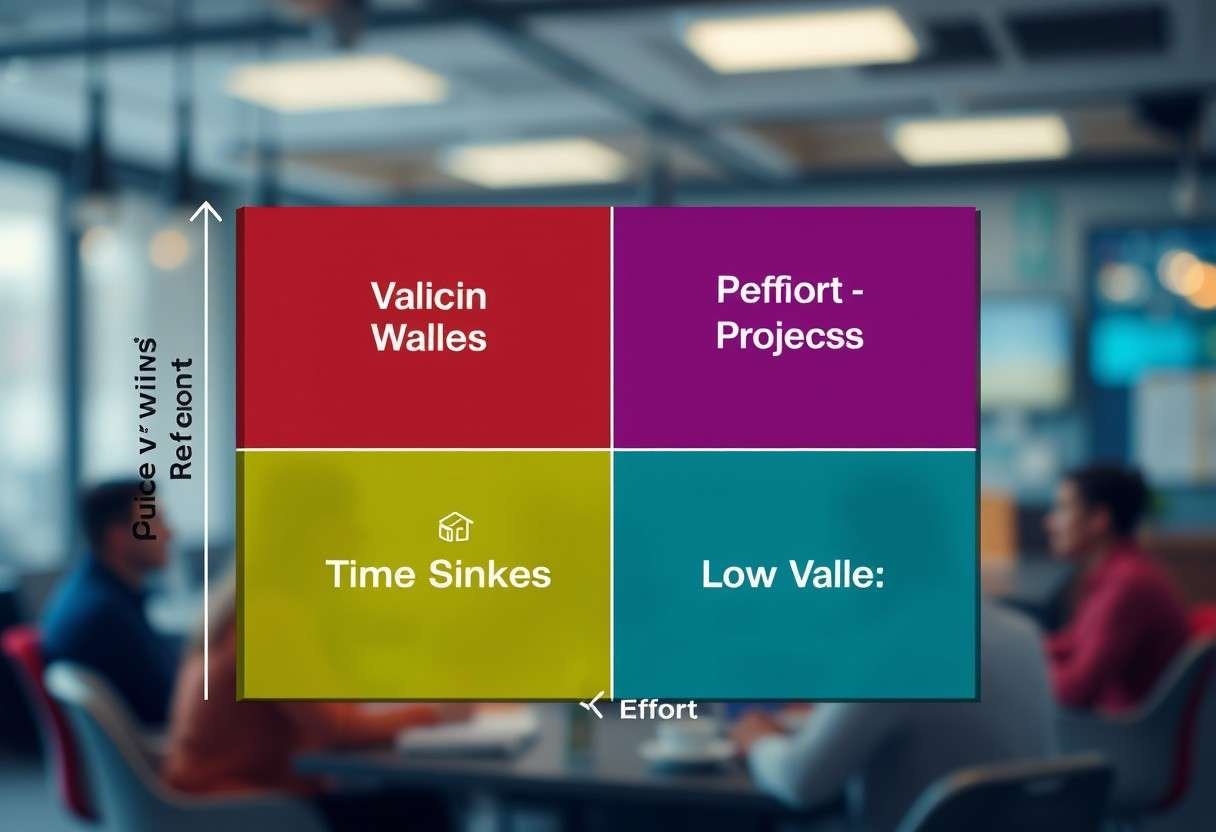Just understanding the balance between value and effort can significantly enhance your product prioritization strategy. In this post, you’ll learn how to create a straightforward matrix that allows you to visualize and assess potential projects effectively. By focusing on high-value and low-effort initiatives, you can maximize your resources and drive project success while avoiding wasted time and effort. Get ready to streamline your decision-making process and ensure that your team works on the initiatives that will bring the greatest return!
Key Takeaways:
- Value Assessment: Evaluate the potential impact of each product feature or project on customer satisfaction and business goals to prioritize high-value items.
- Effort Estimation: Analyze the resources, time, and complexity required to implement each feature, allowing for a balanced approach to prioritization.
- Matrix Visualization: Utilize a simple matrix that maps value against effort, helping teams visually identify which projects should be prioritized for maximum return on investment.
Understanding the Value vs. Effort Matrix
Definition of the Value vs. Effort Matrix
Your ability to prioritize product features effectively is greatly enhanced by using the Value vs. Effort Matrix. This matrix is a visual tool that helps you evaluate various tasks or projects based on their potential value and the effort required to deliver them. By plotting these elements on a simple two-dimensional graph, you can clearly see where to focus your resources for maximum impact, categorizing initiatives into segments that signal quick wins, strategic projects, or areas to avoid.
Value is defined by the benefits that a feature will bring to your users or business. In contrast, effort is determined by the amount of time, resources, and energy needed to complete the task. This distinction allows you to identify opportunities that not only offer high returns but also require manageable investment, making it a vital tool for any product manager or team striving for efficiency.
Importance of Product Prioritization
The importance of product prioritization cannot be overstated in today’s fast-paced market. With limited resources and time, determining which features or projects to tackle first is necessary for maximizing your product’s success. By focusing on initiatives that yield the highest value with the least effort, you ensure that your team remains agile and that your resources are allocated efficiently. This strategic approach helps avoid the common pitfalls of spreading your resources too thin across multiple low-impact projects.
Another crucial aspect to consider is that effective product prioritization helps align your team’s efforts with the overall business objectives. When you focus on high-value initiatives, you not only improve productivity but also enhance customer satisfaction and loyalty. By systematically evaluating and selecting which features to develop based on their value and effort, you amplify the likelihood of achieving a significant impact while minimizing the risk of exhausting your resources on low-yield tasks.
Key Components of the Matrix
If you want to use the Value vs. Effort Matrix effectively, it’s necessary to understand its key components, which typically include four quadrants: Quick Wins, Major Projects, Fill-Ins, and Time Sinks. Quick Wins are the low-effort, high-value initiatives that can quickly propel your project forward. Major Projects involve high value but also require significant effort, thus warranting careful planning. Fill-Ins are low-value, low-effort tasks that can be done when time allows, while Time Sinks represent dangerous high-effort, low-value initiatives that you should be cautious of pursuing.
This matrix offers you a straightforward method for making data-driven decisions in product development, ultimately guiding you to prioritize features that enhance overall success. By categorizing your initiatives within these quadrants, you create a clear visual representation of where your energy should be focused, thus optimizing your strategy to yield tangible outcomes in productivity and user satisfaction.
Factors to Consider When Creating the Matrix
Assuming you are looking to create a robust prioritization matrix, it’s vital to identify and weigh various factors that contribute to the overall success of your product. These considerations should be meticulously evaluated as they can significantly impact your decision-making process. Here’s a brief list of critical factors you should consider:
- User Needs
- Market Demand
- Resource Availability
- Time Constraints
This structured approach will help you align your product development with the ultimate goals of your business.
Identifying User Needs
Assuming you prioritize user satisfaction, identifying user needs forms the backbone of your product prioritization. Begin by gathering insights from your target audience through surveys, interviews, or focus groups. Engage with them to understand their pain points, desires, and the features they value most in a product. This direct communication will allow you to craft solutions that resonate and fulfill actual demands.
In your matrix, you should quantify the **value of user needs** against the effort required to meet them. By mapping out which needs are most critical, you will be able to focus on developing features that will not only satisfy your users but also enhance customer loyalty and retention. This ensures you are leading with empathy and strong market insight.
Assessing Market Demand
One of the fundamental aspects you must address is assessing market demand. Start by conducting market research to identify trends, competitors, and potential gaps in the market. Analyze your competitors’ offerings to determine what they are doing well and where you may have an advantage. Metrics such as search volume for specific keywords, social media engagement, and customer feedback can offer valuable insight into what features or products are currently sought after.
Furthermore, consider the size and growth potential of your target market. A high demand coupled with significant growth potential may warrant prioritization despite the challenges presented. By balancing demand against development efforts, you position your product to tap into lucrative opportunities, making it crucial to factor market demand into your prioritization matrix.
Identifying market demand includes understanding the current needs and preferences of potential customers while also forecasting upcoming trends. The more you know about your audience’s desires, the better you can tailor your offerings to meet their expectations.
Evaluating Resource Availability
To ensure viability, you need to conduct a thorough evaluation of your resource availability. This encompasses personnel, technology, and financial resources that are vital for executing your product plans. Assess your team’s current skills, allocate responsibilities, and determine any necessary training that may be needed. The available budget must be scrutinized as well to gauge what projects or features can realistically be funded.
Balancing the required effort against the available resources helps you avoid overcommitting and ensures you can successfully deliver finished products on time. Another critical aspect to consider is identifying partnerships or outsourcing options that could fill gaps in expertise or capacity. The right alliances might provide you with the resources needed without stretching your internal capabilities too thin.
Understanding Time Constraints
If time is of the essence, it’s crucial to understand the time constraints you face for bringing your product to market. Time-to-market can significantly influence your product’s success, particularly in fast-paced industries where being the first can give you a competitive edge. Prioritize features that can be executed quickly without sacrificing quality or user experience.
The scope of your project could be drastically affected by tight deadlines. By recognizing your speed limit upfront, you align your goals with your capabilities, thereby enhancing team productivity and morale.
The critical takeaway is that you must strategically evaluate each of these factors to create a balanced prioritization matrix. This ensures that you address user needs while simultaneously considering market demand, available resources, and any time constraints you may face. Failing to navigate these intricacies may lead to missed opportunities or, worse, product failures. Understanding each layer will empower you to make informed choices that propel your products towards success.

How to Create the Value vs. Effort Matrix
Once again, understanding how to create a Value vs. Effort Matrix can streamline your product prioritization process. This model allows you not only to evaluate which projects offer the most benefit for the least amount of work but also provides a clear visual representation. For a more in-depth understanding, you can explore the Value vs. Complexity Prioritization Model, which parallels this approach, enhancing your ability to make informed decisions.
Gathering Necessary Data
Necessary data collection is the first step in effectively utilizing the Value vs. Effort Matrix. You should focus on gathering inputs from various stakeholders, including customers, team members, and market research. This information can encompass user feedback, feature requests, and competitive analysis. Making sure you have comprehensive data will help ensure that your assessments of value and effort are as accurate as possible.
In addition, you’d want to categorize your data to highlight key aspects of your product offerings. Data should be organized in ways that accentuate both qualitative and quantitative metrics to capture the necessary elements that drive your product’s success. A meticulous approach will aid you in making informed prioritization decisions.
Defining Value Criteria
With your data in hand, your next task is to define your value criteria. These criteria should reflect the wishes and needs of your target market. You might consider factors such as customer satisfaction, revenue potential, market demand, and competitive advantage. A robust set of value criteria provides a framework for evaluating the overall importance of each potential feature or project.
It is crucial to ensure that the criteria you develop are aligned with your organization’s goals and customer expectations. You should engage your team to validate these criteria, thereby offering a collective understanding of what value means for your products. This collaboration increases buy-in and supports your prioritization efforts moving forward.
Defining Effort Criteria
With the value criteria established, the next step is to define your effort criteria. This should encompass the resources needed to implement each feature, including time, cost, technology requirements, and human resources. Identifying these aspects upfront will allow you to gauge how much effort needs to be invested compared to the value you anticipate receiving.
Criteria for effort should also include any potential risks associated with each project. Understanding the effort involved helps you mitigate challenges before they occur. This dimension gives you a reality check on what you can feasibly accomplish against the anticipated benefits.
Plotting the Matrix
Little effort is required to plot your completed value and effort criteria onto a matrix, where one axis represents value and the other represents effort. Each project should be positioned within the quadrants given its evaluated value and corresponding effort, visually showcasing where your efforts will yield the highest returns. Projects that fall into the high-value, low-effort quadrant are typically your prime targets for immediate action.
Effort placement on the matrix serves as a stark reminder that not all high-value projects will be easy to implement. Address and anticipate the various challenges associated with those that demand more resources to ensure that you can effectively manage their execution while achieving desired outcomes.
Tips for Effective Product Prioritization
Now, to make the process of product prioritization more effective, consider implementing the following tips:
- Involve Cross-Functional Teams
- Use Real-Time Data and Feedback
- Regularly Reassess Priorities
- Balance Short-Term and Long-Term Goals
After incorporating these practices, you will improve your ability to prioritize your product roadmap effectively.
Involve Cross-Functional Teams
For successful product prioritization, it is crucial to involve cross-functional teams in the discussions and decision-making processes. Engaging team members from various departments such as marketing, sales, customer support, and engineering brings diverse perspectives to the prioritization process. This collaboration can lead to a deeper understanding of customers’ needs, market trends, and potential technical challenges.
By fostering an environment where every team member feels valued and empowered to voice their opinions, you not only enhance idea generation but also increase buy-in from all stakeholders involved in the project. This collective approach will ensure that the priorities reflect the organization’s overall vision and strategic objectives, aligning the team’s goals toward your product’s success.
Use Real-Time Data and Feedback
For maintaining an effective prioritization strategy, utilize real-time data and feedback from your users. Gathering qualitative and quantitative insights can help you make informed decisions that cater to your target audience’s demands. Moreover, employing tools and technology to collect data consistently can provide you with ongoing insights into the product’s performance in the market.
A combination of user feedback, sales data, and competitive analysis will empower you to discern where your product stands in comparison to others. By leveraging real-time updates, you can quickly adapt your priorities as the landscape changes.
Regularly Reassess Priorities
Effective product prioritization is not a one-time event but requires you to regularly reassess your priorities based on new developments, market demands, and company goals. Periodically review your current roadmap to ensure that you are still aligned with your strategic aims. This flexibility will allow you to pivot when necessary, particularly if certain initiatives are no longer delivering desired outcomes.
Plus, by checking in on your priorities for relevance, you can ensure there is no stagnation in innovation or adaptation. Evaluating your priorities as market conditions change will keep your projects dynamic and responsive, ultimately enhancing your product’s relevance and competitiveness.
Balance Short-Term and Long-Term Goals
While it’s crucial to focus on delivering short-term results, don’t lose sight of your long-term objectives. Striking this balance will enable you to address immediate needs while paving the way for future growth and innovation. Your product roadmap should therefore incorporate features that not only solve present challenges but also align with your vision for where the product is headed.
ShortTerm considerations might include urgent fixes or new features based on immediate customer feedback, whereas long-term goals should focus on strategic enhancements that align with your brand’s vision and customer retention. A strategic blend ensures you are not overly reactive but remain proactive about your product’s evolution.
Common Mistakes to Avoid
For effective product prioritization using a value versus effort matrix, it’s crucial to avoid some common pitfalls. Familiarizing yourself with these mistakes can significantly enhance your strategic approach. To learn more about this topic, you can refer to the insightful article on Value vs Effort | Hygger University.
Overemphasizing Effort over Value
Little do many teams realize, when you place too much emphasis on the effort required to complete tasks, you might overlook the broader picture of value that those tasks can deliver. This misalignment can lead to missed opportunities for growth and ultimately results in less impactful products. Always remember, the goal is to maximize real value for your users, and focusing solely on effort can obscure that path.
Additionally, overemphasizing effort may cause your team to become disengaged. When team members feel that their hard work isn’t being rewarded with meaningful outcomes, they may lose motivation and productivity. Thus, while effort is a significant element of your matrix, don’t let it overshadow the core value that each task brings to your overall mission.
Ignoring Stakeholder Input
Now is the time to understand the importance of including stakeholder feedback in your prioritization process. Ignoring the insights and needs of your stakeholders can lead to misalignment between what you believe is important and what actually creates value. Stakeholders offer unique perspectives and can provide valuable information that reflects customer demands and market trends.
This input not only enhances the quality of your prioritization matrix but also fosters a sense of collaboration and buy-in from those invested in the project’s outcomes. The more you engage with your stakeholders, the better equipped you will be to make informed decisions that truly cater to their needs and expectations.
Neglecting to Update the Matrix
Input from your team and insights from your stakeholders should not be static. As your project evolves or as new information surfaces, it’s crucial to continually update your prioritization matrix. Failing to do so can lead to a disconnect between your strategy and the actual needs of the market, reducing your product’s effectiveness over time.
Understanding that your initial assessments may change is crucial for maintaining relevance in your approach. Regularly revisiting and revising your matrix ensures that you recognize shifts in values and requirements, ultimately assisting you in adapting your strategies to stay competitive.
Confusing Urgency with Importance
Now, you might find yourself caught in the trap of equating urgency with importance. Just because a task demands immediate attention doesn’t necessarily mean it adds significant value to your project. This confusion can lead to spending too much time on tasks that feel pressing but may not contribute meaningfully to your overall goals.
To prevent this from happening, you must differentiate between what needs quick attention and what genuinely matters for your project’s success. Prioritizing based on importance rather than urgency allows you to focus on significant opportunities that could drive long-term benefits.
Advanced Techniques for Enhanced Prioritization
After mastering the basics of product prioritization using a value versus effort matrix, you may want to examine deeper into advanced techniques to refine your process further. Here’s a structured overview of some strategies that can significantly enhance your prioritization framework:
- Incorporating Weighted Scoring
- Leveraging User Surveys
- Implementing Agile Practices
- Utilizing Software Tools
Incorporating Weighted Scoring
Some prioritize projects based solely on value and effort, but incorporating weighted scoring can offer a more sophisticated approach. In this context, you assign different weights to criteria, which helps ensure that the most critical factors are adequately considered in your final prioritization decisions. By doing this, your matrix will reflect not only the overall effort and potential value but also the relative importance of various attributes.
For example, if customer satisfaction is crucial to your business model, you might give it a higher weight compared to features that might be beneficial but less critical. This method allows you to create a more nuanced prioritization that aligns better with your strategic goals.
Leveraging User Surveys
While quantitative data provides valuable insights for prioritization, qualitative input from your users can add another layer of depth to your understanding. Surveys enable you to gather feedback directly from your target audience, revealing their preferences, pain points, and what they find most valuable. This can directly inform your prioritization efforts and ensure you are meeting market needs effectively.
Moreover, leveraging user surveys can contribute to building customer loyalty, as customers feel valued and understood when their opinions influence product development. It’s critical to **analyze** the survey results to pinpoint trends and prioritize features that resonate most with your audience.
User feedback from surveys can serve as a guiding compass for product enhancement and feature integration. By taking the time to understand your users’ desires, you can align your prioritization efforts with what’s genuinely important to them, ultimately driving better outcomes.
Implementing Agile Practices
Advanced techniques also include adopting Agile practices, which facilitate ongoing prioritization and development. With Agile methodologies, you can create short development cycles, or sprints, allowing you to refine your product based on real-time user feedback. This iterative process means you’re not stuck with the initial ideas but can pivot and adapt based on what users find valuable.
Additionally, Agile practices promote team collaboration and cross-functional communication, enabling various stakeholders in your organization to participate in the product prioritization process. This holistic approach ensures that diverse perspectives are accounted for, leading to a well-rounded prioritization strategy.
Leveraging Agile practices means you can continuously reassess priorities and implement changes rapidly, keeping your product relevant and aligned with market demands.
Utilizing Software Tools
Little do many know that there’s a myriad of software tools designed to streamline the product prioritization process. These tools can help you visualize your prioritization matrix, manage user feedback, and even perform weighted scoring automatically. By using these tools, you can maintain clarity and organization in your prioritization efforts, which can become overwhelming without the right resources.
For example, tools like Aha!, Trello, and Jira can assist you in tracking tasks, gathering user insights, and enabling collaboration within your team—all vital elements for effective prioritization.
Utilizing software tools can enhance your efficiency, allowing you to focus more on strategic decision-making rather than getting bogged down in mundane details. Taking advantage of these technologies empowers you to achieve results faster and with greater accuracy, ensuring your prioritization aligns with business objectives.

Conclusion
From above, you have learned how to create a simple matrix for effective product prioritization by balancing value against effort. This matrix not only aids in visualizing your options but also empowers you to make informed decisions on which products or features to focus on first. By categorizing your potential initiatives into different quadrants—high value/low effort, high value/high effort, low value/low effort, and low value/high effort—you can strategically allocate resources and time, ensuring that you are maximizing the impact of your efforts while minimizing wasted energy on lower-priority tasks. It’s vital to continuously revisit this matrix as market conditions and customer needs evolve, to keep your focus aligned with your business goals.
Incorporating a value versus effort matrix into your product management strategy allows you to prioritize effectively, leveraging your resources where they can create the most significant impact. You should aim to consistently engage stakeholders in this process, ensuring you gather diverse perspectives that enhance your prioritization efforts. By actively integrating this tool into your planning and decision-making processes, you enhance your team’s ability to deliver valuable products that resonate with customers, thus securing a competitive edge in your market. Recall, the ultimate goal is to align your product development efforts with both customer satisfaction and business objectives, paving the way for sustainable growth.
FAQ
Q: What is the Value vs. Effort matrix and how does it aid in product prioritization?
A: The Value vs. Effort matrix is a strategic tool used to evaluate and prioritize product features or projects based on their potential value against the effort required to implement them. By plotting initiatives on a two-dimensional grid where one axis represents value (e.g., revenue, customer satisfaction) and the other represents effort (e.g., time, resources), teams can better understand which projects will yield the highest return for the least investment. This structured approach allows teams to focus on high-value, low-effort initiatives first, ensuring efficient use of resources.
Q: How can teams effectively implement the Value vs. Effort matrix in their product development process?
A: To effectively implement the Value vs. Effort matrix, teams should follow these steps: 1) List all potential features or projects and gather data on their expected value and the estimated effort required for implementation. 2) Create a visual matrix with value plotted on one axis and effort on the other. 3) Position each feature or project within the matrix based on its scored values. 4) Analyze the distribution of the plotted items to identify quick wins (high value, low effort), major projects (high value, high effort), and those that should be reconsidered or deprioritized (low value, low effort). Regularly revisiting the matrix can ensure that it reflects current priorities and market conditions.
Q: What common pitfalls should teams avoid when using the Value vs. Effort matrix?
A: Common pitfalls to avoid when using the Value vs. Effort matrix include: 1) Relying solely on subjective assessments for value and effort—encouraging data-driven evaluations will provide more accurate prioritization. 2) Focusing too much on short-term gains at the expense of long-term strategies; it’s imperative to balance quick wins with initiatives that may require more effort but will deliver significant future value. 3) Failing to communicate and share the prioritization results with all stakeholders, as this might lead to misunderstandings and lack of alignment. Finally, regularly updating the matrix based on new insights and changes in market conditions is vital to ensure its relevance and effectiveness.







